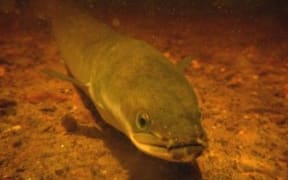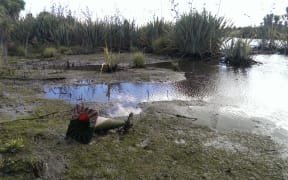A Maori eeling business is warning that the silt killing Christchurch's eels will do irreversible damage unless the sediment is removed urgently.

Robert Dawson holding a meal of traditionally cooked eel. Photo: RNZ / Eru Rerekura
A new study has found the population of traditional kaimoana of Ngāi Tahu, such as eels or tuna, have been decimated by the silt.
Researchers have described the choking of fishlife by tonnes of silt as 'catastrophic'.
Specialists from the University of Canterbury and the National Institute of Water and Atmospheric Research have found the silt, which had accumulated after the earthquakes, to be 30 centimetres deep in some streams.
They said it could take decades for fish numbers to return to previous levels.
A local Māori processor of short finned eel said he had watched his business decline along with the tuna, particularly the 'elvers' which are juvenile eels.
Robert Dawson, of Ngāi Tahu, Ngāti Mamoe and Waitaha, sells traditionally smoked eel and says the silt must be removed.
"The fish numbers in the water have declined extremely badly and are in such a state that those fish that are there have to swim further to get to clean water, particularly the elvers. They come in July, August, September and they haven't got the right habitat to live in to get big enough to travel up the waterways."
Mr Dawson said the eels travel by stealth and hide in holes along the river banks and among willow roots, but now the silt has covered them.
He said it was hard for Māori, which act as kaitiaki or guardians of the awa, to watch their traditional kaimoana dying.
"It's our food source, it's a very precious food source, it's a taonga [treasure] to us and to see the habitat going, it's like the nest is broken.
"They've [the Christchurch City Council] done some clearing on the waterways, but they scoop the silt out and dump it on the banks, and I see little elvers trying to get back to the water and in most cases they can't. Some of the bigger fish can because they are more agile.
"It's a sorry state for the waterways. I know it's a big job, but it needs to be done and not just in the Christchurch region or estuary regions down around New Brighton, but even further up towards Halswell and Riccarton - all those rivers."
"I have a grandson who eels around the Avon and pre-earthquakes he had a lot of eels coming to him in the evenings, but now most of them have gone. Some of the big girls are still there, but it's the little ones you don't see - something's got to be done about it."
Mr Dawson believed Ngāi Tahu and the council should work in collaboration to make sure the elvers are rescued and returned to the waterways when silt is removed.
The eel processor said in the last two years the size as well as the number of tuna has diminished and he's buying in eel to smoke rather than take those few that are left.
"This year I've stopped fishing and I've actually purchased eels so I can keep working. The profit of margin is well done but I'm prepared to do that as long as I can keep trading on.
"I'm losing half my business, but I'm prepared to do that to ensure kaitaikitanga and ensure the sustainability of the fishery - to me, that's paramount, otherwise we won't have a fishery."
In a statement, the Christchurch City Council's Acting Unit Manager City Water and Waste, Tim Joyce, defended its approach to the removal of silt:
NIWA found that in the four most heavily silted streams, the only creatures that still survived were a single eel and whitebait.
'The Council has been undertaking sediment removal from waterways since the day of the first earthquake.
'We have removed thousands of tonnes of sediment from many waterways and will continue to do so for another few years to get back to pre-earthquake levels.
'We are also required to remove sediment and restore habitats under the Natural Environment Recovery Program'.
No one from Te Rūnanga o Ngāi Tahu was available for comment.
A spokesperson for the Parliamentary Commissioner for the Environment, Jan Wright, said she did not want to get involved in the issue as she had not conducted a thorough investigation of the issue.



